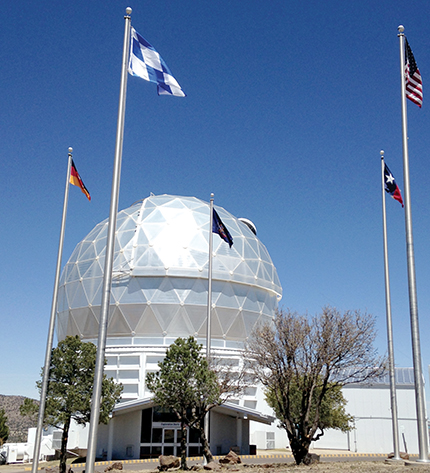Hobby–Eberly Telescope eyes sky with new capabilities
DOI: 10.1063/PT.3.3592
On 9 April, McDonald Observatory in West Texas celebrated the reopening of its 10 m Hobby–Eberly Telescope (HET) after a roughly three-year shutdown for upgrades and the installation of $40 million in instruments.
The telescope is located at an altitude of 2030 m on former mountain ranchlands some 300 km southeast of El Paso. Its primary mirror, made up of 91 hexagonal segments, is at a fixed angle and can rotate to access 70% of the visible sky. With its wide, 22-arcminute field of view, the HET is well-suited for carrying out surveys and hunting for planets.

The Hobby–Eberly Telescope at McDonald Observatory in West Texas was recently rededicated to mark a major upgrade.
TONI FEDER

In its new incarnation, the 20-year-old telescope hosts the Visible Integral-field Replicable Unit Spectrograph (VIRUS), the Habitable Zone Planet Finder (HPF), a low-resolution spectrograph for capturing data from weak sources over wide swaths of sky, and a high-resolution spectrograph for brighter sources. Campaigns to study dark energy and to search for potentially habitable planets will have more than half the observing time. The remaining time is open to competition by the telescope’s four partners: the University of Texas at Austin, the Pennsylvania State University, the University of Göttingen, and Ludwig-Maximillians University of Munich.
So far 16 of 78 VIRUS modules have been installed. The full spectrograph, with 35 000 optical fibers, is slated to be up and running early next year. In the HET Dark Energy Experiment (HETDEX), astronomers use VIRUS to map galaxies in three dimensions at times going back 12 billion years to when the universe was 13% of its current age.
HETDEX collects light for 20 minutes from a given patch of sky. The telescope is then pointed at an adjacent patch. After three and a half years the instrument will have scanned the visible sky with uniform tiling. The “blind blanketing of the universe” as opposed to targeting is an advantage, says Karl Gebhardt of UT Austin, a leader in the experiment. “We get whatever the universe gives us, with no bias by selection.”
Processing the data is not yet automated, so each night the HETDEX team pores through reams of data in search of white dots that could be galaxies; they show up as white dots because as star-forming hot spots they emit mostly at a single hydrogen wavelength.
The aim of HETDEX is to distinguish among cosmological theories about dark energy. Two of the leading theories are that dark energy is a cosmological constant or that it follows from a modification of gravity in Einstein’s theory of general relativity. If it’s a cosmological constant, says Gebhardt, HETDEX will find the value, and then it will be up to theorists to explain why it’s a constant. But if dark energy is the result of a modification of gravity, “we can make important measurements. The galaxies would be either more or less clustered than predicted.” HETDEX could also bolster or knock out other theories, such as that dark energy is a changing cosmological constant or that it’s an illusion conjured by a nonuniform universe.
Among dark-energy experiments, HETDEX’s extent and sensitivity let it look back the furthest in time and put the best constraint on the universe’s expansion rate, Gebhardt says. Because the density of far-away galaxies is low, only about 5% of the light collected will contribute to the galaxy mapping. “There is a wealth of information in the other 95% of data,” he says, “and no one has looked at that part of the universe. We will find massive black holes, star-forming galaxies, and more.”
The other main observational campaign on the HET is a search for habitable planets with the HPF, led by Suvrath Mahadevan of Penn State. It targets red dwarf stars and looks for shifts in their velocities due to the gravitational pull of a companion planet. The instrument works in the near-IR, where red dwarfs are brightest. Light from the HET is carried to the instrument, which is housed at −90 °C in a basement beneath the telescope. The environment is controlled to better than submillikelvin precision.
“We will keep going back to the same stars,” says Mahadevan. “It’s a time-intensive survey, and that’s why HET is so fantastic for this.” Having a share in the telescope is a huge boost, he notes. Getting sufficient time on a large telescope like the Keck would not be possible.
More about the Authors
Toni Feder. tfeder@aip.org





